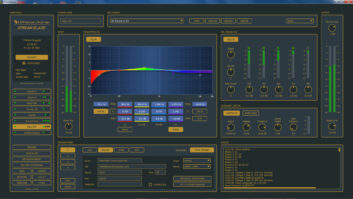
The original and the new Fostex kid on the block sit side by side. In 1982, Fostex introduced the 6301B Personal Monitor, a compact and sturdy powered loudspeaker. It has served the radio and television industries well as a control room monitor, in addition to the live sound world and even ham radio. Now, Fostex brings us the redesigned 6301N series. How does the redesign compare to the original and to other speakers in its class?
I was interested in taking a look at the upgraded design because I’ve had an original 6301B sitting on my workbench for years. I’ve used it primarily as a piece of test gear for checking audio outputs, or for any other situations where confidence monitoring was needed. It has taken quite a beating in its time yet still performs admirably, owing to its cast aluminum case and metal grille, design features retained in the 6301N.
Not much larger than a box of Pop-Tarts, the 6301N is small enough to fit just about anywhere audio monitoring is needed. The optional EB-6301 U-bracket provides additional installation options. The 6301NX and 6301NE monitor accepts both balanced XLR and 1/4-inch unbalanced connections. The 6301ND version accepts AES/EBU digital signals and the 6301NB accepts 1/4-inch unbalanced connections. The controls are simple: an on/off button and a volume pot. One improvement is that both controls are recessed, preventing them from being bumped, or even sheared off, from rough handling or other accidental impacts. Another improvement is the inclusion of a standard IEC power inlet on the back. The original had a permanently attached two-prong power cord.

The redesigned 4-inch driver is fed by a 20 W Class D amplifier, which gives it ample power for most applications. As with the original, this monitor provides plenty of volume for its size, but the 6301N sounded clearer on the sources I ran through it. Granted, a single 4-inch driver is not going to give you “studio” quality, but the 6301N will give you a good idea of how audio will translate to less ideal playback conditions. It will definitely fit the bill in an edit suite, voice over booth, or even in a noisy server/transmitter room. Even though the spec sheet says it bottoms out at 70 Hz, it does a decent job of reproducing bass in music mixes. Highs were no sweat, with the response topping out at 15 kHz. Since analog FM radio doesn’t reproduce anything above 15 kHz, I don’t think this will be a problem.
The $250 street price for one monitor may seem steep, given its size and output; but considering its sturdy construction and durability, it will be a long time before you replace it. Sure, you can buy larger, better-sounding studio monitors in this price range; but how many of them will survive an errant screwdriver or a dive off the top of an equipment rack? If I could suggest one additional feature (when they redesign it again 30 years from now!), it would be to add a mic stand mount, as a speaker like this would make a good miniature stage monitor.
For information, contact Fostex at [email protected]or visit www.fostexinternational.com.
Curt Yengst, CSRE, is a frequent contributor to Radio World.












